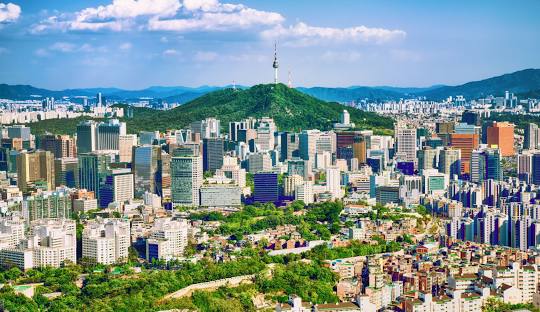
South Korea
The Han River is located in the central part of the Korean Peninsula. It is a national class 1 river in South Korea. “The Han River” comes from the Korean word ‘Hangaram,’ which means a large stream. In addition to its geographical location across Seoul, the river also benefits from its ability to serve as a link between many other cities in Korea. Also, anyone who sees the long stretch of the Han River will find the scenery beautiful. Beyond its outstanding geographical location, I want to praise and brag about how much the Han River has impacted our country.
First, the Han River has played an important role in history. Since the Three Kingdoms period, the Han River has played an enormous role. Baekje led the heyday with the Han River basin as its capital, and Goguryeo and Silla took over the Han River in turn. The high agricultural productivity of the Han River basin secured production routes through water transportation, and maritime trade routes with China were established, making it very convenient for trade. In addition, after the Three Kingdoms period, the Han River played a significant role as a waterway trade route during the Joseon Dynasty. The Han River has played an important role in history, and its development has always led to the development of Korea, which is why many countries throughout history have tried to control it.
Secondly, the Han River helped Korea’s rapid economic development, creating the ‘Miracle of the Han River’. The miracle of the Han River is derived from the miracle of the Rhine River, which was called the miracle of West Germany’s rapid rise to a developed country after its defeat in World War II, and was compared to the Han River by emphasizing that Korea, which fought the Korean War and was devastated in terms of land and manpower, should achieve the same results as West Germany.” This continued through the 1960s, 1970s, and mid-1980s as South Korea implemented five-year plans for economic development after gaining independence from Japan in 1945 and losing a quarter of its land in the Korean War in 1950.
In 1960, the country began to build infrastructure, as it was urgent to lay the foundation for economic activities, and in 1962, the first Five-Year Plan for Economic Development was launched to expand energy resources, and many products that used electricity and coal appeared. Also, the Second Five-Year Plan for Economic Development, which began in 1967, aimed to promote self-sufficiency in food and industrialization and led to the construction of industrial complexes, the Gyeongin Expressway in 1969 and the Gyeongbu Expressway in 1970. At this time, the Han River was still pre-industrialized, so the water quality was clean. Moreover, the Third Five-Year Plan for Economic Development aimed to achieve a stable balance by promoting heavy chemical industrialization. At this time, the Pohang General Steel Works was completed, and the Ulsan Shipyard was hollowed out, which had a significant impact. However, the Han River fell in hard times. The Fourth Five-Year Plan, which began in 1977, aimed for a self-sustaining growth structure based on growth, equity, and efficiency and implemented a value-added tax that merged complex tax categories into one. At this time, industrialization increased, and sewage, factory pollution, and domestic sewage flowed into the Han River, causing the river’s water quality to deteriorate and swimming to be banned.
The five-year economic development plans continued until the seventh. Once the Han River became polluted and troubled, Korea did not coincidentally fall into economic hardship and social turmoil. The Sampung Department Store, the biggest department store, collapsed. The Seongsu Bridge collapsed in 1997 when the Korean economic crisis broke out. In 1998, the government scrapped the economic development plan at the IMF’s request to ensure the freedom of private economic activity and incorporate market order. This plan led to the rapid growth of the Korean economy. Although this was a difficult period for the country as a whole, it was during this time that the Han River was revitalized, and the country’s economy recovered. It is the “Miracle of the Han River” that made Korea what it is today. Korea is the only country in the world that has changed from a recipient of foreign aid to a donor of aid, and some countries admire it. The Miracle of the Han River was introduced because the Han River was not directly responsible for Korea’s economic growth, but the Han River has an influential geographical location and people’s views in Korea, so it is analogized to Korea’s economic development.
Third, the Han River brings many people a sense of relaxation and calm. A walk along the river’s lush green waters is a great way to escape the noise of the city center and feel peaceful. The parks along the Han River are also a favorite place for people to connect with nature and exercise. The Han River has become a meeting place, and a small society has been created. The Han River also provides a place for learning and art. Many festivals and events are held against the Han River’s backdrop, which brings people joy and energy. In addition, the architecture and sculptures along the Han River awaken the artistic sense and enhance the aesthetic value of the city. An excellent example of the fox and stability that the Han River brings to many people was presented. Recently, the 2030 River City Seoul has also been unveiled, creating a buzz as people look forward to working at companies on the Han River. The idea is to create a river city based on the geographical characteristics and economic development of the Han River. You can take the Han River River Bus to work at your office on the river and enjoy floating hotels, festivals, and other activities with your family and friends on weekends. According to a survey by the Seoul Metropolitan Government, before the COVID-19 outbreak in 2020, the number of people using the Han River was 69 million on land and 900,000 on water. The Seoul Metropolitan Government said it will implement plans to build infrastructure and tourism facilities for the city’s residents through 55 leading projects under the River City 4 Nuclear New Strategy. “If you look at the use of rivers in major cities around the world, the Thames River in London, the Hudson River in New York, the Seine River in Paris, and the Sumida River in Tokyo have various types of ships,” said Seoul Mayor Oh Se-hoon. “We will make the Han River not just a place to go on weekends, but a place to eat, sleep, and play, and a place to reflect on oneself through true relaxation.” Through these examples, we can see that the Hangang River is now entrenched in our lives and development and that we are even looking towards River City, which has introduced architecture and sculpture.
In conclusion, historically and economically, the Han River has always played an important role in Korea. Also, it has always shaped the lives of Koreans. It also symbolizes a better future for Korea because it always reminds us of the importance of environmental protection. In the past, the water quality of the Han River was good. Still, it was increasingly polluted by polluted water and waste from factories. But today, thanks to the efforts of the Korean government and people, the Han River is now clear and clean. This is a good reminder of the importance of environmental protection and the value of hard work, and it can serve as an excellent example for other countries today. That’s why the future Korea has the power to overcome whatever happens in the future, just like the past. After seeing the “Miracle of the Han River,” many people want to become a country that develops the country. I believe that creating a “second Miracle of the Han River” for a more developed Korea is what we need to do for the country now.
By: Hwang Ye won
Write and Win: Participate in Creative writing Contest & International Essay Contest and win fabulous prizes.


